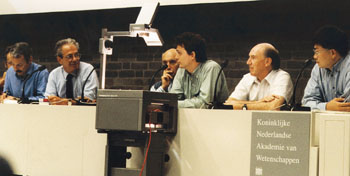Neutrinos are never far from the physics headlines. Neutrino oscillations when different types of neutrinos transform among themselves has emerged as the big talking point of 1998. A topical workshop in Amsterdam surveyed the latest results and looked to the implications.
Neutrino oscillations continuous changes of neutrino type or “flavour” might not only explain the observed lack of neutrinos from the Sun and the atmosphere, but may also provide a very sensitive probe for tiny mass differences between neutrinos of different flavour. These possibilities were on the agenda on 6 September when 130 physicists from all over the world gathered in an Amsterdam brewery for the Neutrino Oscillation Workshop NOW’98.
Recently the SuperKamiokande underground experiment in Japan presented evidence for neutrino oscillations and thereby neutrino mass. Although these masses are believed to be much smaller than that of any other particle, neutrinos are so abundant that they would even with such a tiny mass contribute significantly to the mass of the universe and to its gravitational fate.

At NOW’98, recent results presented in morning sessions provided ground for discussions on the future directions of neutrino oscillation physics during the afternoons.
The workshop opened with a talk by M Nakagawa (Meijo), a godfather of neutrino oscillations, who covered the underlying theory from a historical perspective. Currently available data and their phenomenological implications were reviewed by G L Fogli (Bari), while P G Langacker (Pennsylvania) focused on fundamental aspects of neutrino masses and mixing.
Atmospheric neutrino data were presented by W Gajewski (Irvine), of course paying much attention to the recent SuperKamiokande result. K Nishikawa (KEK) explained how from next year, neutrinos produced at the KEK laboratory will be detected by SuperKamiokande, 250 kilometres away. This will be the first of probably several “long baseline” experiments; in the US plans are being drawn up to direct a neutrino beam over 730 kilometres from Fermilab to the Soudan mine, while in Europe a neutrino beam could be directed from CERN to the Italian Gran Sasso underground laboratory at a similar distance.
The afternoon sessions concentrated on the theory of neutrino oscillations, on solar and atmospheric neutrino experiments, short, medium and long-baseline experiments, reactor experiments and on neutrino beams.
In one morning session, S Sarkar (Oxford) brought cosmology down to earth, showing how measurements of the cosmological microwave background radiation and scenarios for the development of large-scale structures in the universe can constrain the mass of neutrinos and may even require neutrinos to be massive.







